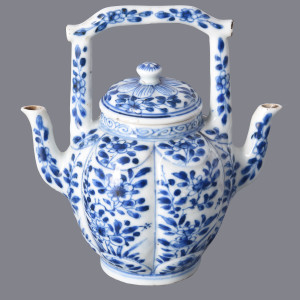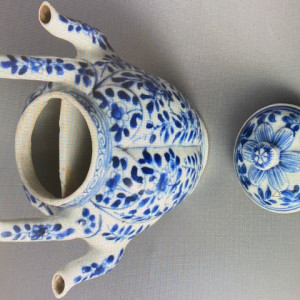BG72
Further images
The ovoid hexafoil body painted with flower-stems and foliage, repeated to the spouts and upright bracket handle and cover, the interior with a central partition.
Literature
Provenance: The late J.B. da Silva (1918-2003) who inherited the teapot from his father-in-law in 1973.
Exhibited: Oriental Ceramics Society, 1983, No. 28
Footnote: As tea drinking became increasingly popular in Europe in the 17th century, tea wares of Chinese porcelain found a ready market. This traditionally Chinese type was used to serve two different types of tea.
Compare with a similar blue and white example in the collection of the Chitra Museum, London, No. 889.
Similar form Famille Verte examples are illustrated by, Regina Khahl, OCS Exhibition, 2016, China without Dragons, p. 310, no. 184. The author notes, 'A yixing teapot of this double form, and Western copy of it, were in the collection of Augustus the Strong of Saxony (r.1694-1733) and are preserved in the Zwinger Collection in Dresden.' Another illustrated by Dr C.J.A. Jorg, Chine de Commande from the Royal Museums of Art and History in Brussels, Exhibition at Flagstaff House Museum of Tea ware, Hong Kong, 30.11.1989 to 27.02.1990, and another similar Famille Verte example can be seen in the collection of the Metropolitan Museum , New York, Accession no. 79.2.1317a,b, For another similar example decorated in underglaze blue, see the Indianapolis Museum of Art, accession no. 1994.224A-B.






